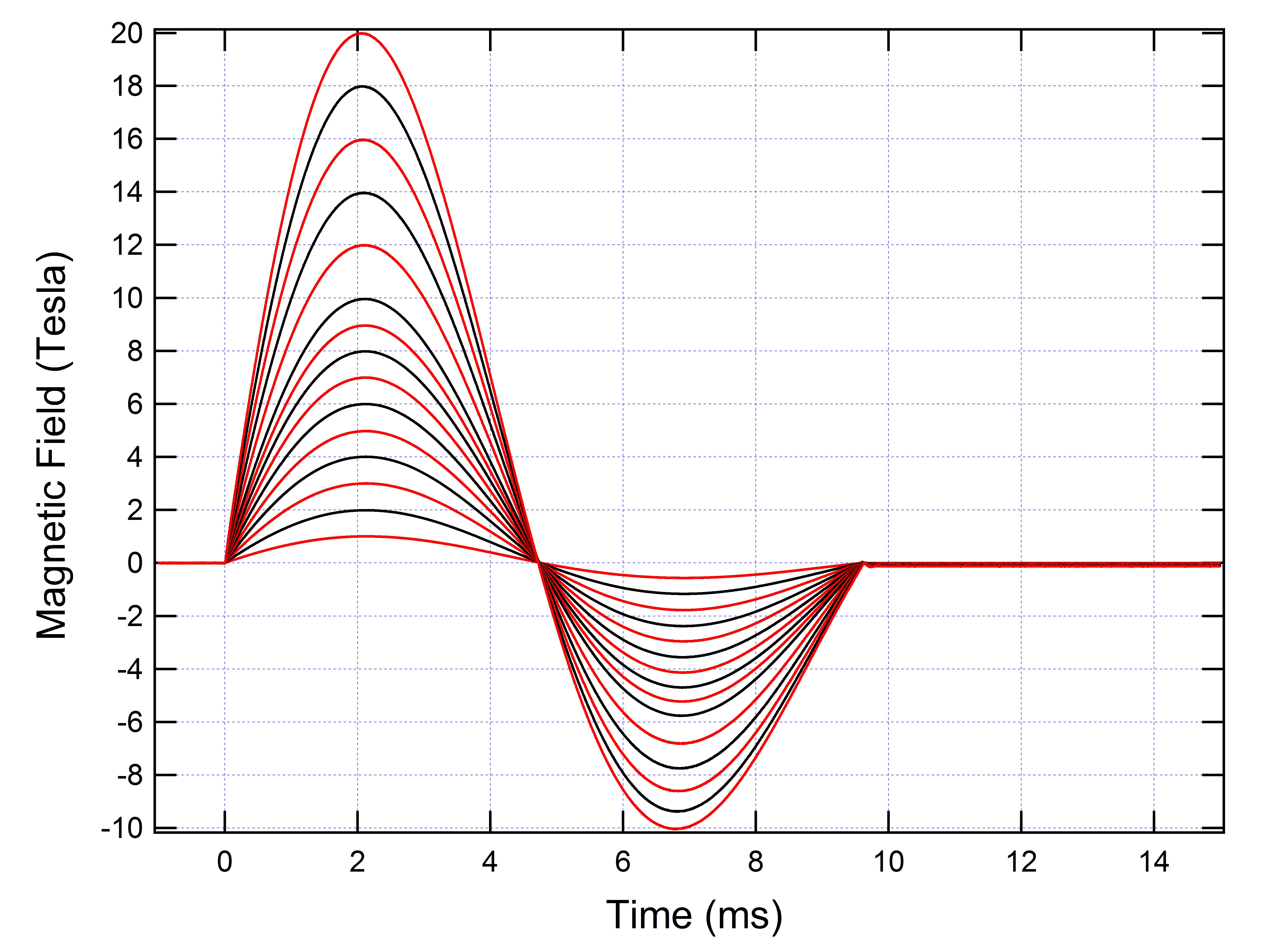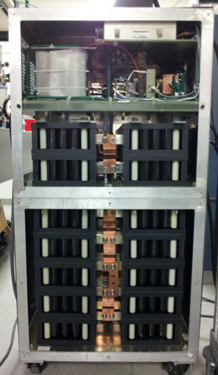We have developed a truly unique experimental facility called the Rice Advanced Magnet with Broadband Optics (RAMBO). This facility houses ultracompact pulsed magnets capable of producing a peak field of 25, 30, and 50 Tesla combined with an arsenal of state-of-the-art instruments for modern materials research. A unique feature of this system is the marriage of a strong magnetic field and ultrashort laser pulses from nearly “DC to daylight.” This unconventional coupling of two extreme conditions will likely lead to new scientific knowledge, advancing the frontier of materials research. We have expanded RAMBO-I to RAMBO-II with help from the Major Research Instrumentation grant from NSF by extending the magnetic field strength and measurement bandwidth.
Illustration by Tanyia Johnson/Rice University
RAMBO represents a new type of experimental facility, one that mates low-cost, high-field pulsed magnets that feature excellent optical access to the sample with state-of-the-art ultrafast optical probing at a wide range of wavelengths. We have built a highly flexible and usable optical system around the RAMBO Magnet, providing a variety of sources and detectors, covering wavelengths in the terahertz (~200 µm), the mid-infrared (MIR) (~3-16 µm), and the near-infrared (NIR)/visible regime (~0.8 µm and harmonics), all with ~100 fs time resolution.
Figure 1: Top: Exponentially damped half-sine wave profile. Bottom: Exponentially damped single sine wave profile. The Top uses a ‘crowbar’ diode antiparallel to the coil, and the Bottom uses a diode antiparallel to the thyristors.
Figure 2: 5.6 mF capacitor bank on casters making the system portable.
Figure 3: 1.25″ diameter mini-coil, similar to the 1.7″ diameter coil used in the system.
The RAMBO Magnet is a pulsed mini-coil magnet (Fig. 3) with a bore of 12 mm × 58 mm, allowing for optical access in a cone half-angle of 12.4°. It produces peak fields of 30 T with a pulse length of ~10 ms (Fig. 1). It is liquid-nitrogen-cooled and can generate 30 T pulses at the rate of ~1 per 10 minutes, or 5-7 T pulses every 1 minute. The Magnet is fed by a capacitor-bank pulse generator (Fig. 2). In continuous use, the Magnet draws less than 1 kW of average electrical power from a standard outlet.
Figure 4: The RAMBO Magneto-optical cryostat system attached to the table-top.
The sample is held in the Magnet’s bore by a hollow sapphire cold finger (Fig. 4) attached to a separate cryostat. Front-side access to the sample is unimpeded within the cone angle of 23.4°, allowing for a high numerical aperture (NA = 0.20). The hollow sapphire cold finger allows backside access to the sample for well-collimated or weakly-focused optical beams. Thus, optics experiments can be performed in transmission or reflection. It will be possible to insert and/or collect essentially any combination of wavelengths via free space with good focusing ability, good spatial resolution, and with low dispersion. This is a quantum leap above magnets with limited optical access, which are severely constrained in all these aspects of performance.
Main Research Equipment:
- Amplified Ti:Sapphire Laser (Clark-MXR, Inc. CPA-2001)
- 2 TOPAS OPAs (Light Converstion Ltd.)
- Silicon Charged Coupled Device (CCD)
Video Clip introducing the RAMBO Lab:
RAMBO-II
The first addition to the RAMBO facility is a dedicated IR/VIS magnet capable of generating peak fields up to 50 T – the most powerful magneto-spectroscopic solenoid outside of a national facility. Driven by one of a pair of new configurable capacitor banks at 2 mF, the mini-coil magnet with a bore of 3 mm x 28 mm produces a ~2 ms pulse and can generate 50 T pulses every 41 minutes, or 10 T every 3 minutes. The small bore requires that light be collected by an optical fiber placed behind the sample.
RAMBO-II EUV is our first split-coil magnet designed for reflectance geometry. The two coils individually produce peak fields as high as 35 T, which reduces to 25 T in the gap during 1.1 ms pulses at 2 mF. The magnet is cooled by a closed-cycle refrigerator and can pulse to 20 T every 20 minutes. For low-field experiments, the magnet can be pulsed at 1 T or below as frequently as the capacitor bank charge rate allows. The magnet is coupled with an EUV beamline driven by high-harmonic generation (HHG) to create a unique experimental capability for magneto-spectroscopy at high field and high photon energies (20 – 60 eV, high harmonic generation).
Main Research Equipment:
- Supercontinuum Laser (NKT Photonics SuperK Extreme)
- Frame-Transfer EMCCD (Princeton Instruments ProEM 512BK)
- 100 kHz Femtosecond Beamline (Active Fiber Systems)
The single-shot terahertz spectroscopy currently employed in RAMBO-I will also receive an upgrade in the form of a dual-coil 50 T magnet. This system uses two larger nested coils producing lower fields to generate 50 T, in contrast to the single small-bore solenoid used in RAMBO-II IR/VIS. Two new 9.6/2.4/2 mF configurable high-voltage capacitor banks have been delivered to enable independent driving of these coils, as well as simultaneous operation of more than one magnet in the RAMBO family.
Articles:
- G. T. Noe II, H. Nojiri, J. Lee, G. L. Woods, J. Léotin, and J. Kono, “A Table-Top, Repetitive Pulsed Magnet for Nonlinear and Ultrafast Spectroscopy in High Magnetic Fields Up to 30 T,” Review of Scientific Instruments 84, 123906 (2013). (Rice News, arXiv)
- G. T. Noe II, Q. Zhang, J. Lee, E. Kato, G. L. Woods, H. Nojiri, and J. Kono, “Rapid Scanning Terahertz Time-Domain Magnetospectroscopy with a Table-Top Repetitive Pulsed Magnet,” Applied Optics 53, 5850 (2014). (arXiv)
- G. T. Noe II, I. Katayama, F. Katsutani, J. J. Allred, J. A. Horowitz, D. M. Sullivan, Q. Zhang, F. Sekiguchi, G. L. Woods, M. C. Hoffmann, H. Nojiri, J. Takeda, and J. Kono, “Single-Shot Terahertz Time-Domain Spectroscopy in Pulsed High Magnetic Fields,” Optics Express 24, 30328 (2016). (arXiv)
- X. Li, K. Yoshioka, M. Xie, G. T. Noe II, W. Lee, N. Marquez Peraca, W. Gao, T. Hagiwara, O. S. Handgard, L.-W. Nien, T. Nagao, M. Kitajima, H. Nojiri, C.-K. Shih, A. H. MacDonald, I. Katayama, J. Takeda, G. A. Fiete, and J. Kono, “Terahertz Faraday and Kerr Rotation Spectroscopy of Bi$_{1-x}$Sb$_x$ Films in High Magnetic Fields up to 30 Tesla,” Physical Review B 100, 115145 (2019). (arXiv)
- A. Baydin, T. Makihara, N. Marquez Peraca, and J. Kono, “Time-Domain Terahertz Spectroscopy in High Magnetic Fields,” Frontiers of Optoelectronics 14, 110 (2021). (arXiv)
- T. Makihara, K. Hayashida, G. T. Noe II, X. Li, N. Marquez Peraca, X. Ma, Z. Jin, W. Ren, G. Ma, I. Katayama, J. Takeda, H. Nojiri, D. Turchinovich, S. Cao, M. Bamba, and J. Kono, “Ultrastrong Magnon-Magnon Coupling Dominated by Antiresonant Interactions,” Nature Communications 12, 3115 (2021). (arXiv, Rice News)
- A. Baydin, F. G. G. Hernandez, M. Rodriguez-Vega, A. K. Okazaki, F. Tay, G. T. Noe II, I. Katayama, J. Takeda, H. Nojiri, P. H. O. Rappl, E. Abramof, G. A. Fiete, and J. Kono, “Magnetic Control of Soft Chiral Phonons in PbTe,” Physical Review Letters 128, 075901 (2022). (arXiv, Rice News)
- F. Tay, A. Baydin, F. Katsutani, and J. Kono, “Magneto-optical Spectroscopy with RAMBO: A Table-Top 30 T Magnet,” Journal of the Physical Society of Japan 91, 101006 (2022). (arXiv)
- A. Baydin, K. Hayashida, T. Makihara, F. Tay, X. Ma, W. Ren, G. Ma, G. T. Noe II, I. Katayama, J. Takeda, H. Nojiri, S. Cao, M. Bamba, and J. Kono, “Magnetically Tuned Continuous Transition from Weak to Strong Coupling in Terahertz Magnon Polaritons,” Physical Review Research 5, L012039 (2023). (arXiv)
- F. G. G. Hernandez, A. Baydin, S. Chaudhary, F. Tay, I. Katayama, J. Takeda, H. Nojiri, A. K. Okazaki, P. H. O. Rappl, E. Abramof, M. Rodriguez-Vega, G. A. Fiete, and J. Kono, “Observation of Interplay between Phonon Chirality and Electronic Band Topology,” Science Advances 9, eadj4074 (2023). (arXiv, Rice News)
- T. E. Kritzell, A. Baydin, F. Tay, R. Rodriguez, H. Nojiri, H. O. Everitt, I. Barsukov, and J. Kono, “Terahertz Cavity Magnon Polaritons,” Advanced Optical Materials 12, 2302270 (2024). (arXiv)








